The Light Field Market is estimated to be valued at USD 2.0 billion in 2025 and is projected to reach USD 8.0 billion by 2035, registering a compound annual growth rate (CAGR) of 15.0% over the forecast period. This represents a strong upward trajectory, supported by rising adoption across imaging, display, and simulation applications where depth perception and high-fidelity visuals are critical. Between 2025 and 2027, growth from USD 2.0 billion to USD 2.6 billion is driven by increased integration in sectors such as media production, medical imaging, and advanced visualization tools, where immersive viewing experiences enhance end-user engagement and decision-making precision.
From 2028 to 2030, the market accelerates from USD 3.0 billion to USD 4.0 billion, indicating intensified deployment in automotive HUD systems, interactive advertising, and scientific research applications. This phase benefits from broader industry acceptance, cost efficiencies in production, and an expanding base of software ecosystems supporting light field data processing. The five-year period from 2025 to 2030 reflects a robust compound pace, underscoring the market’s position as a high-growth segment within advanced imaging technologies. By the end of this phase, light field solutions are expected to move from niche adoption toward broader commercial implementation, setting the stage for continued double-digit growth through 2035.
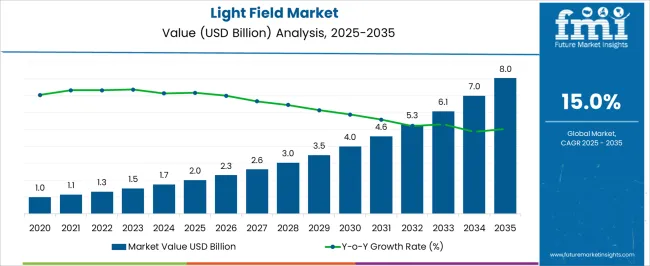
| Metric | Value |
|---|---|
| Light Field Market Estimated Value in (2025 E) | USD 2.0 billion |
| Light Field Market Forecast Value in (2035 F) | USD 8.0 billion |
| Forecast CAGR (2025 to 2035) | 15.0% |
The light field market is evolving rapidly as industries shift toward volumetric capture, immersive visualization, and real-time 3D content generation. This technology is enabling photorealistic imaging and spatial data reconstruction, which is being increasingly adopted in sectors such as entertainment, automotive, medical diagnostics, and AR/VR platforms.
Hardware miniaturization, along with increasing investment in light field-based sensors and AI-enhanced image processing, is accelerating innovation. Additionally, growing demand for spatially aware content, particularly in head-mounted displays and virtual production environments, is expanding commercial use cases.
Collaborations between tech companies and creative studios are enhancing production workflows and interactive content experiences. As light field systems become more accessible and cost-effective, the market is expected to witness significant traction in simulation training, gaming, and diagnostic imaging.
The light field market is segmented by technology, application, and geographic regions. The light field market is divided into Imaging solutions, 3D mapping & modelling, 3D rendering, 3D scanning, Image reconstruction, Layout & animation, and Light field display. In terms of application, the light field market is classified into Entertainment & media, Aerospace & defense, Architecture & engineering, Automotive, Healthcare, Industrial, and Retail. Regionally, the light field industry is classified into North America, Latin America, Western Europe, Eastern Europe, Balkan & Baltic Countries, Russia & Belarus, Central Asia, East Asia, South Asia & Pacific, and the Middle East & Africa.
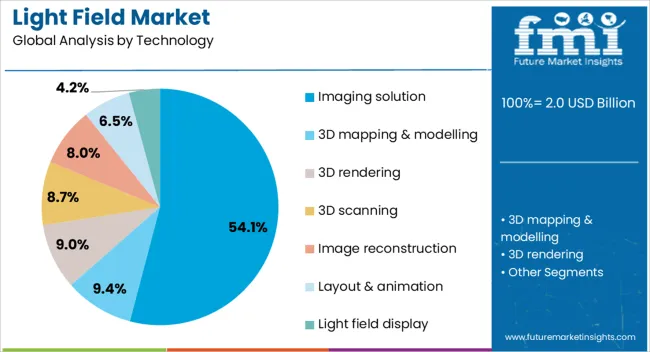
Imaging solution technology is expected to account for 54.1% of the total revenue in the light field market by 2025, making it the dominant technological segment. This leadership has been supported by the demand for high-resolution spatial image capture, which is essential for creating depth-rich content in AR/VR, automotive vision, and medical imaging.
The ability of imaging solutions to generate real-time parallax and capture light rays at multiple angles has improved accuracy and realism in 3D scene reconstruction. Innovations in multi-lens arrays, microlens integration, and CMOS sensor architecture have enhanced both fidelity and processing speed.
As industries transition from flat imaging to data-rich spatial rendering, the scalability and precision of imaging solutions are positioning this segment at the forefront of adoption.
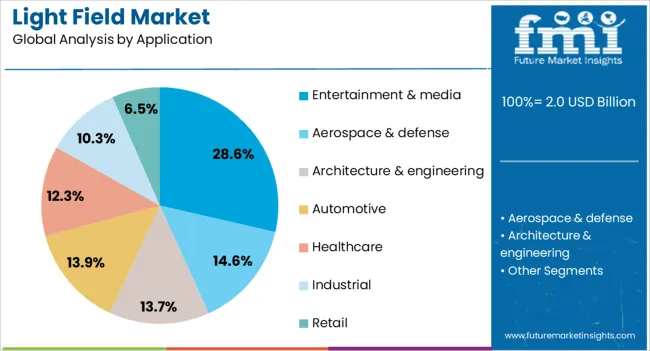
Entertainment and media are projected to represent 28.6% of the light field market’s revenue in 2025, making it the leading application segment. The growth of this segment is being driven by the increasing use of immersive content across gaming, virtual film production, and live entertainment formats.
Light field technology offers depth-enhanced visuals and viewer interaction capabilities that improve realism in cinematic scenes and interactive environments. Studios and content platforms are adopting volumetric capture to support virtual set design and real-time character rendering, enabling richer storytelling experiences.
As consumer demand rises for 3D content compatible with headsets and next-gen displays, entertainment and media are expected to remain the largest contributors to market expansion.
The light field market is expanding as industries leverage advanced imaging for immersive visual experiences, depth mapping, and precise 3D reconstruction. Light field technology captures the direction and intensity of light rays, enabling post-capture refocusing, high-fidelity AR and VR content, and enhanced machine vision. Growth is driven by entertainment, medical imaging, autonomous systems, and industrial inspection applications. Challenges include high computational requirements, limited standardization, and high production costs. Opportunities lie in consumer electronics integration, next-generation displays, and cloud-based light field processing solutions.
The growing popularity of AR, VR, and mixed reality platforms is accelerating the adoption of light field technology. By recording light rays in multiple directions, light field systems allow users to experience realistic depth, natural focus shifts, and true-to-life textures. Gaming, cinema, and virtual collaboration platforms benefit from the enhanced realism and interactivity this technology offers. Content creators and device manufacturers are increasingly exploring light field capture for next-generation headsets and holographic displays. This demand is expected to strengthen further as immersive applications become more mainstream and accessible to consumers.
Despite its benefits, light field technology faces barriers to mass adoption due to high hardware costs, large data volumes, and complex processing requirements. Capturing and rendering light field data requires specialized cameras, high-speed processors, and substantial storage capacity, which limits affordability for consumer-level applications. In addition, the lack of standardized formats and workflows slows ecosystem development. To overcome these challenges, companies are investing in hardware miniaturization, compression algorithms, and cloud-based rendering platforms, aiming to deliver light field experiences at lower cost without compromising performance or visual fidelity.
Beyond entertainment, light field technology is gaining traction in medical diagnostics, microscopy, and industrial inspection. In healthcare, light field imaging enables precise 3D visualization for surgical planning and non-invasive diagnostics, improving accuracy and patient outcomes. In manufacturing and quality control, light field cameras provide depth data for detecting defects and measuring complex surfaces without physical contact. These capabilities align with growing needs for high-precision imaging in mission-critical environments. As adoption spreads across specialized sectors, light field providers can diversify their revenue streams and reduce reliance on entertainment-based demand.
North America leads the light field market due to strong R&D investment, the presence of leading technology companies, and early adoption in media production. Europe follows with applications in medical imaging, automotive safety systems, and cultural heritage preservation. Asia Pacific is emerging as a high-growth region, driven by its expanding consumer electronics industry, large-scale gaming markets, and government-backed research programs. Collaborative efforts between academic institutions, hardware manufacturers, and software developers are accelerating innovation and commercialization, positioning multiple regions for strong market growth in the coming years.
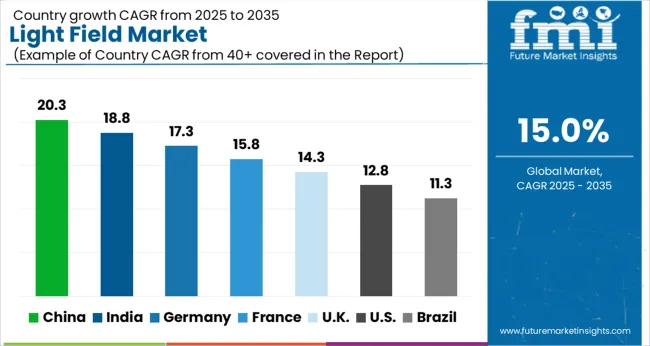
The global light field market is experiencing rapid expansion with a robust CAGR of 15.0%, driven by advancements in imaging and display technologies. Among key players, China leads the growth at 20%, propelled by significant investments in research and manufacturing capabilities. India follows closely at 19%, supported by emerging technology adoption and innovation hubs. Germany records 17% growth, reflecting strong industrial R&D and regulatory support. France grows at 16%, driven by advancements in optics and visualization applications. The United Kingdom and the United States, mature markets, exhibit growth rates of 14% and 13% respectively, fueled by continuous innovation and integration of light field technologies across sectors. These countries collectively shape market trends through breakthroughs in imaging resolution, computational photography, and display efficiency. This report includes insights on 40+ countries; the top countries are shown here for reference.
China leads the global light field market with a remarkable 20% CAGR, driven by robust government backing and aggressive private sector investment. The country’s rapid digital transformation has fostered widespread adoption of light field technologies in entertainment, healthcare, and augmented reality (AR). Chinese technology giants are pioneering research in light field cameras and display systems, leveraging AI and computational imaging to enhance realism. The booming film and gaming industries create high demand for immersive visual content, while the healthcare sector uses light field imaging for precise diagnostics and surgical planning. Compared to other countries, China’s integrated supply chain and large-scale manufacturing capabilities allow for faster commercialization and competitive pricing. Challenges such as patent restrictions and the need for skilled professionals remain. With government policies promoting smart cities and digital innovation, China is poised to maintain its leadership and expand the applications of light field technology in industrial automation and smart devices.
Llight field market in India is growing rapidly at 19% CAGR, fueled by rising digital media consumption and expanding AR/VR ecosystems. While lagging slightly behind China, India benefits from a young, tech-savvy population eager to adopt new technologies, especially in urban centers. The media and entertainment industries use light field imaging to enhance film production and gaming experiences, but healthcare applications are gaining attention for improved medical imaging. Unlike China’s scale, India faces challenges including limited R&D infrastructure and fragmented market players, yet partnerships between startups and global companies are bridging these gaps. The government’s Digital India initiative and investment in smart city projects create a favorable environment for growth. Additionally, increasing smartphone penetration and improved internet connectivity accelerate adoption of light field-based mobile and web applications. Compared to more mature markets, India’s cost-sensitive buyers drive demand for affordable, scalable solutions, pushing innovation in low-cost light field camera modules.
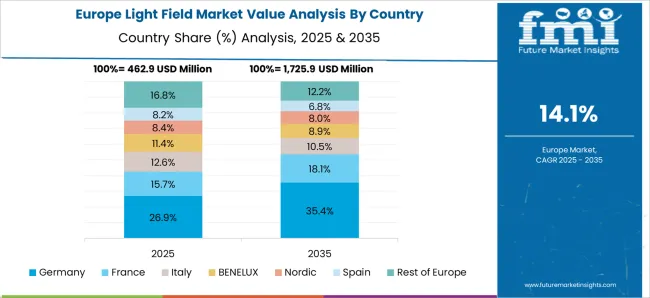
Germany holds a strong position in the light field market with a 17% CAGR, supported by its advanced manufacturing and automotive sectors. Unlike China and India where media drives demand, Germany’s light field adoption is deeply rooted in industrial applications such as precision imaging for quality control and augmented reality for training and design. German companies invest significantly in research and development, focusing on next-generation light field sensors and display technologies that integrate with Industry 4.0 standards. Government funding supports innovation, especially for projects enhancing real-time monitoring and automation in factories. Additionally, the country’s entertainment sector increasingly uses light field technology for film and virtual experiences but on a smaller scale compared to Asia. Germany’s strict data privacy and environmental regulations shape the development of sustainable and secure light field devices. The market growth is also supported by collaborations between universities and industry leaders aiming to expand the technology’s applications beyond manufacturing into healthcare and education.
The United Kingdom light field market, expanding at 14% CAGR, shows balanced growth across creative industries, healthcare, and academia. Unlike China’s industrial dominance or India’s rapid consumer adoption, the UK focuses on leveraging light field technology for high-value sectors such as film production, visual effects, and interactive education. The British film industry uses light field cameras to create more realistic and immersive visual content, enhancing viewer engagement. Healthcare applications, including advanced diagnostic imaging and surgical planning, are emerging as significant growth drivers, supported by collaboration between NHS institutions and tech startups. Universities in the UK play a critical role in advancing research and nurturing innovation through funding and partnerships. While the market is mature compared to developing countries, challenges such as limited large-scale manufacturing and investment constraints persist. The UK also benefits from a strong creative economy that increasingly demands cutting-edge imaging technology, positioning the country as a hub for light field content creation and research.
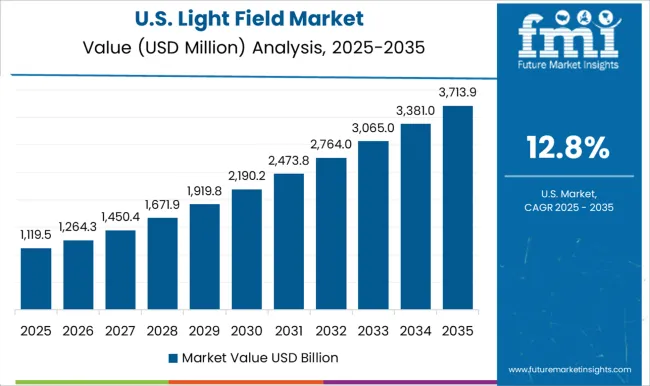
The United States market for light field technology is growing steadily at a 13% CAGR, driven by substantial investments in augmented reality (AR), entertainment, and medical imaging. Unlike China’s government-driven growth or India’s rapid adoption, the USA market is led by private-sector innovation and a mature technology ecosystem. Major technology companies and startups focus on developing advanced light field cameras and display systems to enhance realism in gaming, film, and virtual experiences. Healthcare applications such as diagnostics and treatment planning increasingly use light field imaging to improve patient outcomes. Strong collaborations between universities, government agencies, and private companies accelerate research and commercialization. Despite a slower CAGR compared to Asian markets, the USA benefits from high technology penetration, intellectual property strength, and a robust funding environment. The growing hybrid and remote work culture also fuels demand for immersive communication tools utilizing light field technology, expanding its applications beyond traditional sectors.
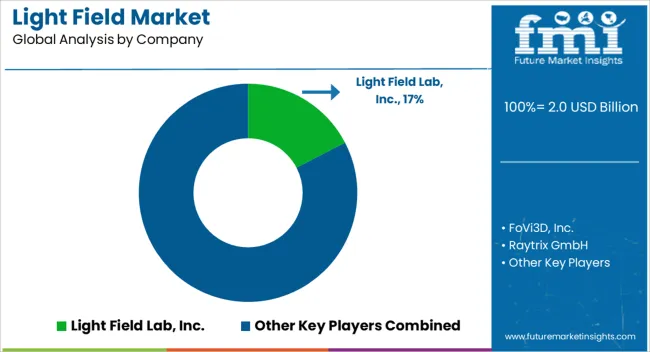
The Light Field Market features a dynamic mix of established electronics giants and specialized innovators, with key players including Light Field Lab, Inc., FoVi3D, Inc., Raytrix GmbH, Avegant Co., Google LLC, Holografika, Lumii Inc., NVIDIA Corporation, OTOY Inc., Panasonic Corporation, Japan Display, Inc., Leia, Inc., Samsung Display Co. Ltd., Ricoh Innovations Corporation, Sony Corporation, and Toshiba Corporation. These companies are advancing display and imaging technologies that capture and reproduce full light field information direction, color, and intensity enabling true holographic visuals without headgear.
Light Field Lab, FoVi3D, and Holografika lead in developing large-scale, high-resolution holographic displays, targeting entertainment, simulation, and visualization markets. Raytrix focuses on light field camera technology, enabling depth mapping and refocusing for industrial, medical, and scientific imaging. NVIDIA and OTOY drive software rendering engines and GPU-based platforms for real-time light field content generation, while Google, Sony, and Samsung leverage their display expertise to bring light field panels closer to commercial readiness.
Applications are emerging in AR/VR headsets, automotive HUDs, telepresence, medical imaging, and retail displays. The growing demand for immersive media, fueled by the metaverse and next-gen visualization systems, is accelerating R&D investment. However, widespread adoption remains limited by high production costs, processing power requirements, and content creation challenges. The competitive edge now hinges on breakthroughs in micro-optics manufacturing, AI-assisted rendering, and compact, energy-efficient light field panels. Partnerships between display hardware makers and content software providers are becoming more common, aiming to solve both the hardware bottleneck and the need for native light field content pipelines.
In the AR/VR and immersive display space, several major players have made significant strides using light field technology. Samsung introduced its Odyssey 3D gaming monitor in August 2024, offering a glasses-free 3D gaming experience that enhances immersion and realism. Sony followed with the release of a light field headset in 2025, designed with ultra-lightweight materials and advanced AR capabilities, making it suitable for both consumer and enterprise use.
| Item | Value |
|---|---|
| Quantitative Units | USD 2.0 Billion |
| Technology | Imaging solution, 3D mapping & modelling, 3D rendering, 3D scanning, Image reconstruction, Layout & animation, and Light field display |
| Application | Entertainment & media, Aerospace & defense, Architecture & engineering, Automotive, Healthcare, Industrial, and Retail |
| Regions Covered | North America, Europe, Asia-Pacific, Latin America, Middle East & Africa |
| Country Covered | United States, Canada, Germany, France, United Kingdom, China, Japan, India, Brazil, South Africa |
| Key Companies Profiled | Light Field Lab, Inc., FoVi3D, Inc., Raytrix GmbH, Avegant Co., Google LLC, Holografika, Lumii Inc., NVidia Corporation, OTOY Inc., Panasonic Corporation, Japan Display, Inc., Leia, Inc., Samsung Display Co. Ltd., Ricoh Innovations Corporation, Sony Corporation, and Toshiba Corporation |
| Additional Attributes | Dollar sales vary by technology, with imaging solutions and light field displays; by application, spanning media & entertainment, healthcare, automotive, defense, and industrial; and by region, led by North America and Asia-Pacific. Growth is driven by 3D visualization demand, AR/VR adoption, computational imaging, and AI-enabled rendering. |
The global light field market is estimated to be valued at USD 2.0 billion in 2025.
The market size for the light field market is projected to reach USD 8.0 billion by 2035.
The light field market is expected to grow at a 15.0% CAGR between 2025 and 2035.
The key product types in light field market are imaging solution, 3D mapping & modelling, 3D rendering, 3D scanning, image reconstruction, layout & animation and light field display.
In terms of application, entertainment & media segment to command 28.6% share in the light field market in 2025.






Our Research Products

The "Full Research Suite" delivers actionable market intel, deep dives on markets or technologies, so clients act faster, cut risk, and unlock growth.

The Leaderboard benchmarks and ranks top vendors, classifying them as Established Leaders, Leading Challengers, or Disruptors & Challengers.

Locates where complements amplify value and substitutes erode it, forecasting net impact by horizon

We deliver granular, decision-grade intel: market sizing, 5-year forecasts, pricing, adoption, usage, revenue, and operational KPIs—plus competitor tracking, regulation, and value chains—across 60 countries broadly.

Spot the shifts before they hit your P&L. We track inflection points, adoption curves, pricing moves, and ecosystem plays to show where demand is heading, why it is changing, and what to do next across high-growth markets and disruptive tech

Real-time reads of user behavior. We track shifting priorities, perceptions of today’s and next-gen services, and provider experience, then pace how fast tech moves from trial to adoption, blending buyer, consumer, and channel inputs with social signals (#WhySwitch, #UX).

Partner with our analyst team to build a custom report designed around your business priorities. From analysing market trends to assessing competitors or crafting bespoke datasets, we tailor insights to your needs.
Supplier Intelligence
Discovery & Profiling
Capacity & Footprint
Performance & Risk
Compliance & Governance
Commercial Readiness
Who Supplies Whom
Scorecards & Shortlists
Playbooks & Docs
Category Intelligence
Definition & Scope
Demand & Use Cases
Cost Drivers
Market Structure
Supply Chain Map
Trade & Policy
Operating Norms
Deliverables
Buyer Intelligence
Account Basics
Spend & Scope
Procurement Model
Vendor Requirements
Terms & Policies
Entry Strategy
Pain Points & Triggers
Outputs
Pricing Analysis
Benchmarks
Trends
Should-Cost
Indexation
Landed Cost
Commercial Terms
Deliverables
Brand Analysis
Positioning & Value Prop
Share & Presence
Customer Evidence
Go-to-Market
Digital & Reputation
Compliance & Trust
KPIs & Gaps
Outputs
Full Research Suite comprises of:
Market outlook & trends analysis
Interviews & case studies
Strategic recommendations
Vendor profiles & capabilities analysis
5-year forecasts
8 regions and 60+ country-level data splits
Market segment data splits
12 months of continuous data updates
DELIVERED AS:
PDF EXCEL ONLINE
Light Field Cameras Market Size and Share Forecast Outlook 2025 to 2035
Light Pipe Mould Market Size and Share Forecast Outlook 2025 to 2035
Lightning Surge Protector Market Size and Share Forecast Outlook 2025 to 2035
Light Therapy Market Forecast and Outlook 2025 to 2035
Light Rail Traction Converter Market Size and Share Forecast Outlook 2025 to 2035
Light Management System Market Size and Share Forecast Outlook 2025 to 2035
Lightweight Corrugator Modules Market Size and Share Forecast Outlook 2025 to 2035
Lightening and Whitening Creams Market Analysis - Size and Share Forecast Outlook 2025 to 2035
Field Inspection Tester Market Size and Share Forecast Outlook 2025 to 2035
Lightweight Automotive Body Panels Market Size and Share Forecast Outlook 2025 to 2035
Lightening / Whitening Agents Market Size and Share Forecast Outlook 2025 to 2035
Light Control Switch Market Size and Share Forecast Outlook 2025 to 2035
Lightweight Handheld Cordless Vacuum Cleaner Market Size and Share Forecast Outlook 2025 to 2035
Light Setting Spray Market Size and Share Forecast Outlook 2025 to 2035
Light-Activated Anti-Pollution Skincare Market Analysis - Size and Share Forecast Outlook 2025 to 2035
Lighting As A Service Market Size and Share Forecast Outlook 2025 to 2035
Light Duty Truck Market Size and Share Forecast Outlook 2025 to 2035
Field Force Automation Market Size and Share Forecast Outlook 2025 to 2035
Light Commercial Vehicle Market Size and Share Forecast Outlook 2025 to 2035
Light Emitting Diode (LED) Backlight Display Market Size and Share Forecast Outlook 2025 to 2035

Thank you!
You will receive an email from our Business Development Manager. Please be sure to check your SPAM/JUNK folder too.
Chat With
MaRIA